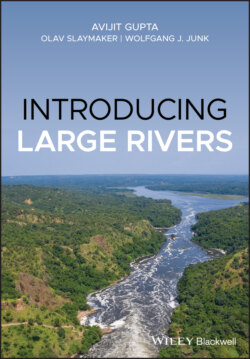Читать книгу Introducing Large Rivers - Avijit Gupta - Страница 31
4.2 Large Rivers from Source to Sink
ОглавлениеImagine a large river that rises in a folded mountain range and flows to the sea and has a gentle offshore gradient (Figure 4.2). The tectonically active mountains of high relief tend to produce large quantities of rock fragments from seismic movements, glaciation, slope failures, and erosion by steep headwaters. The mountainous headwaters of the large river tend to flow in a pattern of deep valleys, are often structure-guided, have steep gradients, and their bed and banks are constituted of coarse sediment and rock. The combination of steep gradient and pulses of high discharge associated with orographic precipitation flush a volume of coarse sediment out of the mountains along river channels. As the rivers exit the mountains, their slopes sharply decrease, causing them to deposit sediment and build triangles of alluvial deposits called fans near the highland-lowland contact (Box 4.1). These fans mask the sharp contact between the mountains and the plain and reduce the gradient of the river. The large trunk river continues for a long distance beyond the fan, over a gentler gradient. Tributaries join it at intervals across the plain, increasing its discharge and sediment load. Finally, the river flows through a set of deltaic distributaries into the sea.
Figure 4.1 At least 10 m high midchannel bar in the Brahmaputra at Sirajganj, Bangladesh; locally known as the Jamuna. A high volume of sand is moved in the wet season and stored during the dry monsoon. Large-scale sedimentary structures are visible. The top of the bar is at several levels.
Source: Gupta 2007.
Figure 4.2 Schematic network of a large river. Compare with the satellite images of several large river basins: Amazon (Figures 3.4 and 4.5) and Ganga (Figure 4.7).
This is a short and simplified description. Form, behaviour and sediment of large rivers, however, vary among themselves. Two rivers, the Amazon and Ganga, are described to establish a general picture and several common properties. Several other rivers are then discussed, to highlight an expected assemblage of form and behaviour of large rivers and variations from such expected outcomes. Form and behaviour of a large river is the combined result of such an expected outcome and deviations therefrom.
